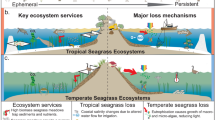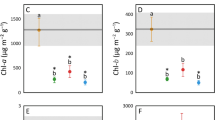Abstract
Although the frequency and magnitude of sedimentation often varies across coastal landscapes creating patches with different mean sediment loads, duration of sedimentation and rates of sediment resuspension, few studies have documented the emergent effects of spatio-temporal variability in sedimentation. Here, we conducted two laboratory experiments to evaluate such effects on the establishment of Macrocystis pyrifera and Undaria pinnatifida spores. In the first experiment, spore establishment was significantly affected by sediment load (the effective dose required for a 40 % reduction in establishment ranged between 16 and 60 mg sediment l−1) and sediment regime (relative sedimentation occurring before spore settlement, ~3 times more sediment was required for 20 % reduction in spore establishment when sedimentation occurred after spore settlement). The second experiment demonstrated that the effects of sediment depended on sediment load (spore establishment was 2–4 times greater when sediment load was 200 mg l−1 relative to 400 mg l−1), variability in sedimentation (spore establishment was 1.36 times greater with variable than fixed sediment loads), repeated pulses of sedimentation (pulsed sedimentation decreased spore establishment by 59–91 % relative to a single sedimentation event) and timing of sedimentation relative to spore settlement (sedimentation before spore settlement decreased establishment by 51–95 % relative to sedimentation after spore settlement). These results have important implications for ecologists and resource managers attempting to predict the consequences of sedimentation, suggesting that it is not only important to consider sediment load, but also fine-scale temporal variability in sedimentation relative to key life-history events of the impacted organisms.




Similar content being viewed by others
References
Abramoff MD, Magalhaes PJ, Ram SJ (2004) Image Processing with ImageJ. Biophotonics Int 11:36–42
Airoldi L (2003) The effects of sedimentation on rocky coast assemblages. Oceanogr Mar Biol Ann Rev 41:161–236
Airoldi L, Cinelli F (1997) Effects of sedimentation on subtidal macroalgal assemblages: an experimental study from a mediterranean rocky shore. J Exp Mar Biol Ecol 215:269–288
Airoldi L, Virgilio M (1998) Response of turf-forming algae to spatial variations in the deposition of sediments. Mar Ecol Prog Ser 165:271–282
Aronson RB, MacIntyre IG, Wapnick CM, O’Neill MW (2004) Phase shifts, alternative states, and the unprecedented convergence of two reef systems. Ecology 85:1876–1891
Balata D, Piazzi L, Benedetti-Cecchi L (2007) Sediment disturbance and loss of beta diversity on subtidal rocky reefs. Ecology 88:2455–2461
Bellwood DR, Hughes TP, Folke C, Nystrom M (2004) Confronting the coral reef crisis. Nature 429:827–833
Burnham KP, Anderson (2002) Model selection and multimodel inference: a practical information-theoretic approach. Springer, New york
Carney LT, Edwards MS (2010) Role of nutrient fluctuations and delayed development in gametophyte reproduction by Macrocystis pyrifera (Phaeophyceae) in southern California. J Phycol 46:987–996
Carter L (1986) A budget for modern Holocene sediment on the South Otago continental shelf. N Z J Mar Freshw Res 20:665–676
Chapman AS, Albrecht AS, Fletcher RL (2002) Differential effects of sediments on survival and growth of Fucus serratus embryos (Fucales, Phaeophyceae). J Phycol 38:894–903
Cie DK, Edwards MS (2008) The effects of high irradiance on the settlement competency and viability of kelp zoospores. J Phycol 44:495–500
Connell SD (2005) Assembly and maintenance of subtidal habitat heterogeneity: synergistic effects of light penetration and sedimentation. Mar Ecol Prog Ser 289:53–61
Deiman M, Iken K, Konar B (2012) Susceptibility of Nereocystis luetkeana (Laminariales, Ochrophyta) and Eualaria fistulosa (Laminariales, Ochrophyta) spores to sedimentation. Algae 27:115–123
DeVinny JS, Volse LA (1978) Effects of sediments on the development of Macrocystis pyrifera gametophytes. Mar Biol 48:343–348
Edwards MS (2000) The role of alternate life-history stages of a marine macroalga: a seed bank analogue? Ecology 81:2404–2415
Eriksson BK, Johansson G (2005) Effects of sedimentation on macroalgae: species-specific responses are related to reproductive traits. Oecologia 143:438–448
Fahey BD, Coker RJ (1992) Sediment production from forest roads in Queen Charlotte forest and potential impact on marine water quality, Marlborough Sounds, New Zealand. N Z J Mar Freshw Res 26:187–195
Foster MS, Schiel D (1985) The ecology of giant kelp forests in California: a community profile. U.S Fish and Wildlife Services, Washington
Fredersdorf J, Muller R, Becker S, Wiencke C, Bischof K (2009) Interactive effects of radiation, temperature and salinity on different life history stages of the Arctic kelp Alaria esculenta (Phaeophyceae). Oecologia 160:483–492
Goff JR, Dunbar GB, Barrett PJ (1998) Monthly to decadal sediment accumulation rates in a semi-enclosed embayment. J Coast Res 14:461–471
Graham MH (2004) Effects of local deforestation on the diversity and structure of southern California giant kelp forest food webs. Ecosystems 7:341–357
Graham MH, Halpern BS, Carr MH (2008) Diversity and dynamics of Californian subtidal kelp forests. In: McClanahan T, Branch G (eds) Food webs and the dynamics of marine benthic ecosystems. Oxford University Press, Oxford, pp 103–134
Grifiths G (1979) High sediment yields from major rivers of the Western Southern Alps, New Zealand. Nature 282:61–63
Hay CH, Luckens PA (1987) The Asian kelp Undaria pinnatifida (Phaeophyta: Laminariales) found in a New Zealand harbour. N Z J Bot 25:329–332
Hicks DM, Gomez B, Trustrum NA (2004) Event suspended sediment characteristics and the generation of hyperpycnal plumes at river mouths: east coast continental margin, North Island, New Zealand. J Geol 112:471–485
Irving AD, Connell SD (2002) Sedimentation and light penetration interact to maintain heterogeneity of subtidal habitats: algal versus invertebrate dominated assemblages. Mar Ecol Prog Ser 245:83–91
Irving AD, Balata D, Colosio F, Ferrando GA, Airoldi L (2009) Light, sediment, temperature, and the early life-history of the habitat-forming alga Cystoseira barbata. Mar Biol 156:1223–1231
Jupiter S, Roff G, Marion G, Henderson M, Schrameyer V, McCulloch M, Hoegh-Guldberg O (2008) Linkages between coral assemblages and coral proxies of terrestrial exposure along a cross-shelf gradient on the southern Great Barrier Reef. Coral Reefs 27:887–903
Kawamata S, Yoshimitsu S, Tanaka T, Igari T, Tokunaga S (2011) Importance of sedimentation for survival of canopy-forming fucoid algae in urchin barrens. J Sea Res 66:76–86
MacDiarmid A, McKenzie A, Sturman J, Beaumont J, Mikaloff-Fletcher S, Dunne J (2012) Assessment of anthropogenic threats to New Zealand marine habitats. New Zealand Aquatic Environment and Biodiversity Report No. 93.255 p
Maldonado M, Giraud K, Carmona C (2008) Effects of sediment on the survival of asexually produced sponge recruits. Mar Biol 154:631–641
McClanahan TR, Obura D (1997) Sedimentation effects on shallow coral communities in Kenya. J Exp Mar Biol Ecol 209:103–122
McCulloch M, Fallon S, Wyndham T, Hendy E, Lough J, Barnes D (2003) Coral record of increased sediment flux to the inner Great Barrier Reef since European settlement. Nature 421:727–730
Menge BA (1991) Relative importance of recruitment and other causes of variation in rocky intertidal community structure. J Exp Mar Biol Ecol 146:69–100
Morelissen B, Dudley BD, Geange SW, Phillips NE (2013) Gametophyte reproduction and development of Undaria pinnatifida under varied nutrient and light conditions. J Exp Mar Biol Ecol 448:197–206
North WJ (1994) Review of Macrocystis biology. In: Akatsuka I (ed) Biology of economic algae. Academic Publishing, The Hague
O’Loughlin CL (1980) Near-shore seawater quality, Marlborough Sounds. N Z J Ecol 3:151
Orth RJ, Carruthers TJB, Dennison WC, Duarte CM, Fourqurean JW, Heck KL, Hughes AR, Kendrick GA, Kenworthy WJ, Olyarnik S, Short FT, Waycott M, Williams SL (2006) A global crisis for seagrass ecosystems. Bioscience 56:987–996
Phillips NE, Shima JS (2006) Differential effects of suspended sediments on larval survival and settlement of New Zealand urchins Evechinus chloroticus and abalone Haliotis iris. J Exp Mar Biol Ecol 314:149–158
R Development Core Team (2013) R: A language and environment for statistical computing. R Foundation for Statistical Computing, Vienna
Reed DC, Raimondi PT, Carr MH, Goldwasser L (2000) The role of dispersal and disturbance in determining spatial heterogeneity in sedentary organisms. Ecology 81:2011–2026
Ritz C, Streibig JC (2005) Bioassay analysis using R. J Stat Softw 12:1–22
Roughgarden J, Gaines S, Pacala S (1987) Supply side ecology: the role of physical transport processes. In: Gee J, Giller P (eds) Organization of communities, past and present, The 27th Symposium of the British Ecological Society. pp, Blackwell Scientific Publications, pp 491–518
Schiel DR, Wood SA, Dunmore RA, Taylor DI (2006) Sediment on rocky intertidal reefs: effects on early post-settlement stages of habitat-forming seaweeds. J Exp Mar Biol Ecol 331:158–172
Silva PC, Woodfield RA, Cohen AN, Harris LH, Goddard JHR (2002) First Report of the Asian kelp Undaria pinnatifida in the Northeastern Pacific Ocean. Biol Invasions 4:333–338
Slattery M, Bockus D (1997) Sedimentation in McMurdo Sound, Antarctica: a disturbance mechanism for benthic invertebrates. Polar Biol 18:172–179
Stephenson G, Milne JR, Sorensen P (2008) Wellington harbour marine sediment quality investigation. Greater Wellington Regional Council
Stewart JG (1983) Fluctuations in the quantity of sediments trapped among algal thalli on intertidal rock platforms in southern California. J Exp Mar Biol Ecol 73:205–211
Stier AC, Geange SW, Hanson KM, Bolker BM (2013) Predator density and timing of arrival affect reef fish community assembly. Ecology 94:1057–1068
Syvitski JPM, Vörösmarty CJ, Kettner AJ, Green P (2005) Impact of humans on the flux of terrestrial sediment to the Global Coastal Ocean. Science 308:376–380
Thornber CS, Kinlan BP, Graham MH, Stachowicz JJ (2004) Population ecology of the invasive kelp Undaria pinnatifida in California: environmental and biological controls on demography. Mar Ecol Prog Ser 268:69–80
Thrush SF, Hewitt JE, Cummings VJ, Ellis JI, Hatton C, Lohrer A, Norkko A (2004) Muddy waters: elevating sediment input to coastal and estuarine habitats. Front Ecol Environ 2:299–306
Underwood AJ, Fairweather PG (1989) Supply-side ecology and benthic marine assemblages. Trends Ecol Evol 4:16–20
Vadas RL, Johnson S, Norton TA (1992) Recruitment and mortality of early post-settlement stages of benthic algae. Br Phycol J 27:331–351
Valentine JP, Johnson CR (2003) Establishment of the introduced kelp Undaria pinnatifida in Tasmania depends on disturbance to native algal assemblages. J Exp Mar Biol Ecol 295:63–90
Walker JW (2007) Effects of fine sediments on settlement and survival of the sea urchin Evechinus chloroticus in northeastern New Zealand. Mar Ecol Prog Ser 331:109–118
Waycott M, Duarte CM, Carruthers TJB, Orth RJ, Dennison WC, Olyarnik S, Calladine A, Fourqurean JW, Heck KL, Hughes AR, Kendrick GA, Kenworthy WJ, Short FT, Williams SL (2009) Accelerating loss of seagrasses across the globe threatens coastal ecosystems. PNAS 106:12377–12381
Acknowledgments
This study was approved by the Ministry of Fisheries under special permit 468, was conducted outside protected marine areas and did not involve any protected species. Permission for the use of Undaria was granted by Ministry for Primary Industries under section 52 and 53 of the Biosecurity Act 1,993. S. Journee and L. Watwood provided invaluable support for field and laboratory work. This project was possible with financial support from the Ministry of Science and Innovation (Grant number E1667).
Author information
Authors and Affiliations
Corresponding author
Additional information
Communicated by F. Bulleri.
Rights and permissions
About this article
Cite this article
Geange, S.W., Powell, A., Clemens-Seely, K. et al. Sediment load and timing of sedimentation affect spore establishment in Macrocystis pyrifera and Undaria pinnatifida . Mar Biol 161, 1583–1592 (2014). https://doi.org/10.1007/s00227-014-2442-6
Received:
Accepted:
Published:
Issue Date:
DOI: https://doi.org/10.1007/s00227-014-2442-6




